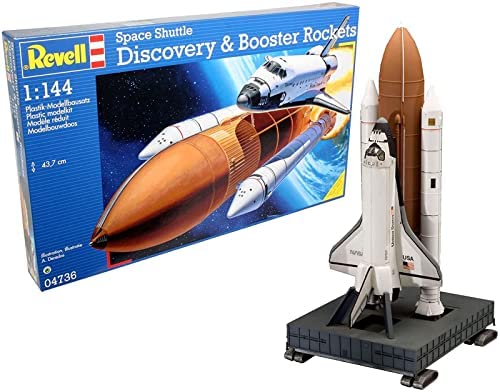Revell - Space Shuttle Discovery &Booster
Revell - Space Shuttle Discovery &Booster
Couldn't load pickup availability
Share
Space Shuttle Discovery & Booster "- Opening the luggage compartment doors- Movable firing arm- External fuel tank with two solid propellant booster rockets- Mobile launch pad- Three detailed rocket engine final stages Super Abziehbilder: -Orbiter "Enterprise", "Discovery", "Atlantis", "Endeavour" before 1998 - Orbiter "Enterprise", "Discovery", "Atlantis", "Endeavour" " after 1998" "The development of a transportation system with reusable main components for NASA began in 1972 at North American Rockwell and a number of other companies. The total weight of the shuttle ready for launch is 2,055 tons. It can carry a payload of 30 tons into an orbit up to 965 km above the earth. The Orbiter prototype, "Enterprise" was completed in 1976. "Enterprise" served to test flight and landing capabilities in the atmosphere and for development of the space shuttles. The first space shuttle, that was launched into space on April 12, 1981, was ""Columbia"." From 1983 onwards, with the completion of several orbiters, NASA significantly intensified their scientific experiments and strategic military activities in cooperation with the US Air Force. Communications and research satellites were carried into space, field repairs were carried out, and the US space station was built and supplied. "Challenger" was launched into space for the first time on April 4, 1983. ""Discovery"" took off for the first time on August 30, 1984. Since October 3, 1985, the fourth space shuttle, ""Atlantis"" , has been used for 26 missions. ""Endeavour"" was first launched on May 7, 1992. This shuttle was equipped with several new pieces of equipment and computers, increasing its capabilities. The orbiters can remain in space for up to 28 days. The enormous structural and thermal stresses to which they are subjected during take-off and landing require constant inspection and maintenance of all components and improvements to the equipment. The heat shield on the front and underside of the shuttle is particularly important and must be regularly inspected and repaired. Due to two tragic accidents in which the entire crew lost their lives, "Challenger"" was lost in 1986 and ""Columbia"" in 2003. Flights resumed after a two-year interruption and extensive modifications to the orbiters and aircraft. main tank. When it landed at Edwards Air Force Base, California, on 9 August 2005, the 31st flight of ""NASA space shuttle mission to a successful conclusion. When shuttle flights resume in the next few years, construction of the International Space Station ISS will continue. The European space laboratory ""Columbus"" will also participate." The development of a reusable transport system for the main components for NASA began in 1972 at North American Rockwell.Maistab 1/144.97 Details.43.7 cm long.Suitable for ages +12.


